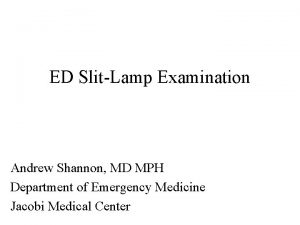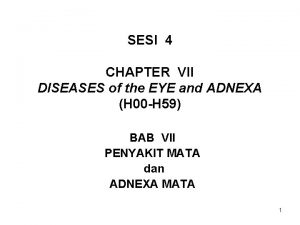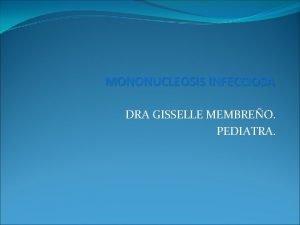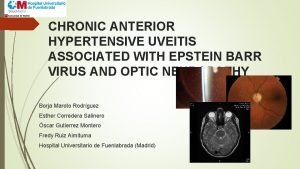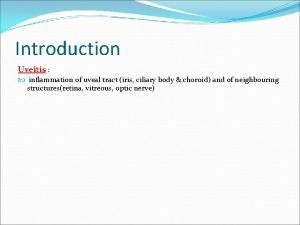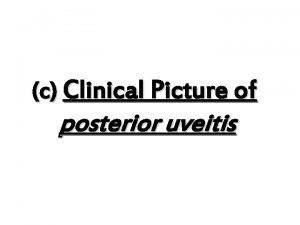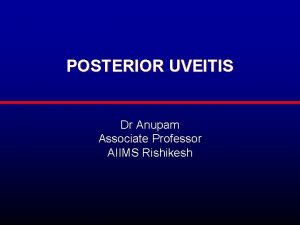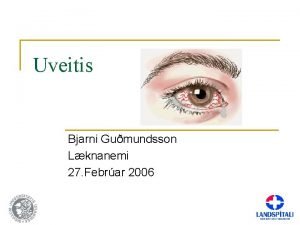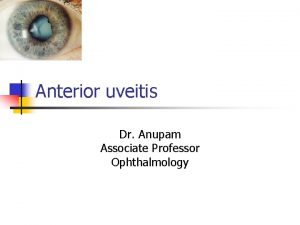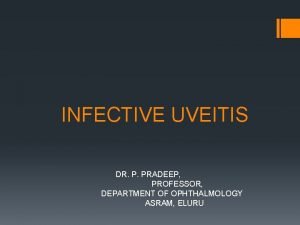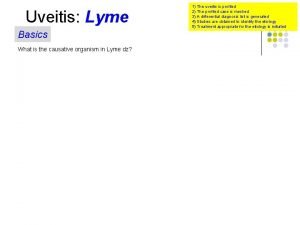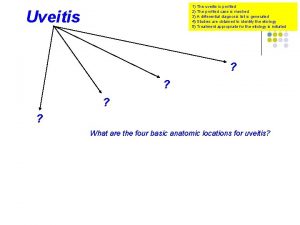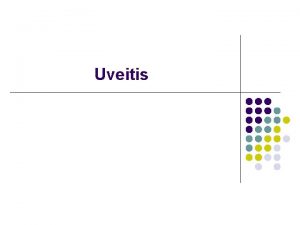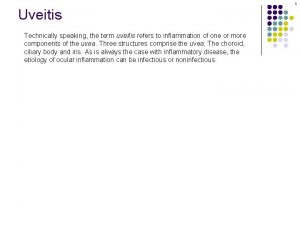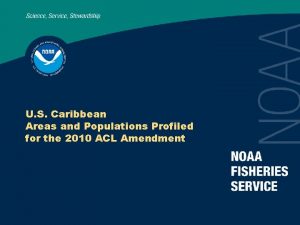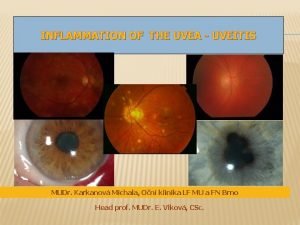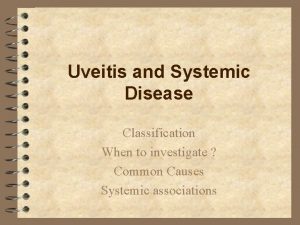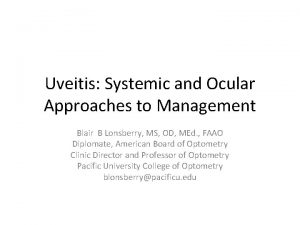1 The uveitis is profiled 2 The profiled

























































































- Slides: 89

1) The uveitis is profiled 2) The profiled case is meshed 3) A differential diagnosis list is generated 4) Studies are obtained to identify the etiology 5) Treatment appropriate for the etiology is initiated Uveitis ? ? What are the four basic anatomic locations in which uveitis can originate?

Uveitis 1) The uveitis is profiled 2) The profiled case is meshed 3) A differential diagnosis list is generated 4) Studies are obtained to identify the etiology 5) Treatment appropriate for the etiology is initiated Panuveitis Posterior Intermediate Anterior What are the four basic anatomic locations in which uveitis can originate?

Uveitis 1) The uveitis is profiled 2) The profiled case is meshed 3) A differential diagnosis list is generated 4) Studies are obtained to identify the etiology 5) Treatment appropriate for the etiology is initiated Panuveitis? Posterior? Intermediate? Anterior? Which location is most likely to manifest uveitis caused by Bartonella?

Uveitis 1) The uveitis is profiled 2) The profiled case is meshed 3) A differential diagnosis list is generated 4) Studies are obtained to identify the etiology 5) Treatment appropriate for the etiology is initiated Panuveitis Posterior Intermediate Anterior Which location is most likely to manifest uveitis caused by Bartonella?

Uveitis: Posterior If inflammation is located… 1) The uveitis is profiled 2) The profiled case is meshed 3) A differential diagnosis list is generated 4) Studies are obtained to identify the etiology 5) Treatment appropriate for the etiology is initiated Primarily in the choroid In both the choroid and the retina Primarily in the retina Involving the ONH and the retina It is called: ? ? What do we call each form of uveitis?

Uveitis: Posterior If inflammation is located… 1) The uveitis is profiled 2) The profiled case is meshed 3) A differential diagnosis list is generated 4) Studies are obtained to identify the etiology 5) Treatment appropriate for the etiology is initiated Primarily in the choroid In both the choroid and the retina Primarily in the retina Involving the ONH and the retina It is called: Choroiditis Chorioretinitis or Retinochoroiditis Retinitis Neuroretinitis What do we call each form of uveitis?

Uveitis: Posterior If inflammation is located… 1) The uveitis is profiled 2) The profiled case is meshed 3) A differential diagnosis list is generated 4) Studies are obtained to identify the etiology 5) Treatment appropriate for the etiology is initiated Primarily in the choroid In both the choroid and the retina Primarily in the retina Involving the ONH and the retina It is called: Choroiditis? Chorioretinitis or Retinochoroiditis? Retinitis? Neuroretinitis? With which form is Bartonella most likely to present?

Uveitis: Posterior If inflammation is located… 1) The uveitis is profiled 2) The profiled case is meshed 3) A differential diagnosis list is generated 4) Studies are obtained to identify the etiology 5) Treatment appropriate for the etiology is initiated Primarily in the choroid In both the choroid and the retina Primarily in the retina Involving the ONH and the retina It is called: Choroiditis Chorioretinitis or Retinochoroiditis Retinitis Neuroretinitis With which form is Bartonella most likely to present?

Uveitis: Posterior If inflammation is located… 1) The uveitis is profiled 2) The profiled case is meshed 3) A differential diagnosis list is generated 4) Studies are obtained to identify the etiology 5) Treatment appropriate for the etiology is initiated Primarily in the choroid In both the choroid and the retina Primarily in the retina Involving the ONH and the retina It is called: Choroiditis Chorioretinitis or Retinochoroiditis Retinitis Neuroretinitis ? ? ? What are some of the other causes of neuroretinitis? ? ? ? Bartonellosis

Uveitis: Posterior If inflammation is located… 1) The uveitis is profiled 2) The profiled case is meshed 3) A differential diagnosis list is generated 4) Studies are obtained to identify the etiology 5) Treatment appropriate for the etiology is initiated Primarily in the choroid In both the choroid and the retina Primarily in the retina Involving the ONH and the retina It is called: Choroiditis Chorioretinitis or Retinochoroiditis Retinitis Neuroretinitis Syphilis/sarcoid/TB Toxocariasis Toxoplasmosis What are some of the other causes of neuroretinitis? Lyme DUSN Malignant HTN Increased ICP AION Leber’s idiopathic stellate neuroretinitis Bartonellosis

Uveitis: Posterior If inflammation is located… 1) The uveitis is profiled 2) The profiled case is meshed 3) A differential diagnosis list is generated 4) Studies are obtained to identify the etiology 5) Treatment appropriate for the etiology is initiated Primarily in the choroid In both the choroid and the retina Primarily in the retina Involving the ONH and the retina It is called: Choroiditis Chorioretinitis or Retinochoroiditis Retinitis Neuroretinitis Syphilis/sarcoid/TB Toxocariasis Toxoplasmosis What are some of the other causes of neuroretinitis? Lyme DUSN Of these, which is the most common cause? Malignant HTN Increased ICP AION Leber’s idiopathic stellate neuroretinitis Bartonellosis

Uveitis: Posterior If inflammation is located… 1) The uveitis is profiled 2) The profiled case is meshed 3) A differential diagnosis list is generated 4) Studies are obtained to identify the etiology 5) Treatment appropriate for the etiology is initiated Primarily in the choroid In both the choroid and the retina Primarily in the retina Involving the ONH and the retina It is called: Choroiditis Chorioretinitis or Retinochoroiditis Retinitis Neuroretinitis Syphilis/sarcoid/TB Toxocariasis Toxoplasmosis What are some of the other causes of neuroretinitis? Lyme DUSN Of these, which is the most common cause? Bartonella, by a mile Malignant HTN Increased ICP AION Leber’s idiopathic stellate neuroretinitis Bartonellosis

Uveitis: Bartonellosis Basics What is the causative organism in Bartonellosis? 1) The uveitis is profiled 2) The profiled case is meshed 3) A differential diagnosis list is generated 4) Studies are obtained to identify the etiology 5) Treatment appropriate for the etiology is initiated

Uveitis: Bartonellosis Basics What is the causative organism in Bartonellosis? Bartonella henslae 1) The uveitis is profiled 2) The profiled case is meshed 3) A differential diagnosis list is generated 4) Studies are obtained to identify the etiology 5) Treatment appropriate for the etiology is initiated

Uveitis: Bartonellosis Basics What is the causative organism in Bartonellosis? Bartonella henslae What sort of organism is it (in a microbiology sense)? 1) The uveitis is profiled 2) The profiled case is meshed 3) A differential diagnosis list is generated 4) Studies are obtained to identify the etiology 5) Treatment appropriate for the etiology is initiated

Uveitis: Bartonellosis Basics What is the causative organism in Bartonellosis? Bartonella henslae What sort of organism is it (in a microbiology sense)? rod vs cocci It is a bacterium, specifically a rod 1) The uveitis is profiled 2) The profiled case is meshed 3) A differential diagnosis list is generated 4) Studies are obtained to identify the etiology 5) Treatment appropriate for the etiology is initiated

Uveitis: Bartonellosis Basics What is the causative organism in Bartonellosis? Bartonella henslae What sort of organism is it (in a microbiology sense)? It is a bacterium, specifically a rod 1) The uveitis is profiled 2) The profiled case is meshed 3) A differential diagnosis list is generated 4) Studies are obtained to identify the etiology 5) Treatment appropriate for the etiology is initiated

Uveitis: Bartonellosis Basics What is the causative organism in Bartonellosis? Bartonella henslae What sort of organism is it (in a microbiology sense)? It is a bacterium, specifically a rod Is it Gram positive, or Gram negative? 1) The uveitis is profiled 2) The profiled case is meshed 3) A differential diagnosis list is generated 4) Studies are obtained to identify the etiology 5) Treatment appropriate for the etiology is initiated

Uveitis: Bartonellosis Basics What is the causative organism in Bartonellosis? Bartonella henslae What sort of organism is it (in a microbiology sense)? It is a bacterium, specifically a rod Is it Gram positive, or Gram negative? It is G(-) 1) The uveitis is profiled 2) The profiled case is meshed 3) A differential diagnosis list is generated 4) Studies are obtained to identify the etiology 5) Treatment appropriate for the etiology is initiated

Bartonella henslae: Gram(-) rods

Uveitis: Bartonellosis Basics What is the causative organism in Bartonellosis? Bartonella henslae What sort of organism is it (in a microbiology sense)? It is a bacterium, specifically a rod Is it Gram positive, or Gram negative? It is G(-) How are humans infected? 1) The uveitis is profiled 2) The profiled case is meshed 3) A differential diagnosis list is generated 4) Studies are obtained to identify the etiology 5) Treatment appropriate for the etiology is initiated

Uveitis: Bartonellosis Basics What is the causative organism in Bartonellosis? Bartonella henslae What sort of organism is it (in a microbiology sense)? It is a bacterium, specifically a rod Is it Gram positive, or Gram negative? It is G(-) How are humans infected? Via a bite, scratch or lick from a cat (especially kittens) 1) The uveitis is profiled 2) The profiled case is meshed 3) A differential diagnosis list is generated 4) Studies are obtained to identify the etiology 5) Treatment appropriate for the etiology is initiated

Uveitis: Bartonellosis Basics What is the causative organism in Bartonellosis? Bartonella henslae What sort of organism is it (in a microbiology sense)? It is a bacterium, specifically a rod Is it Gram positive, or Gram negative? It is G(-) How are humans infected? Via a bite, scratch or lick from a cat (especially kittens) What is the common name for Bartonellosis? 1) The uveitis is profiled 2) The profiled case is meshed 3) A differential diagnosis list is generated 4) Studies are obtained to identify the etiology 5) Treatment appropriate for the etiology is initiated

Uveitis: Bartonellosis Basics What is the causative organism in Bartonellosis? Bartonella henslae What sort of organism is it (in a microbiology sense)? It is a bacterium, specifically a rod Is it Gram positive, or Gram negative? It is G(-) How are humans infected? Via a bite, scratch or lick from a cat (especially kittens) What is the common name for Bartonellosis? Cat-scratch disease (CSD) 1) The uveitis is profiled 2) The profiled case is meshed 3) A differential diagnosis list is generated 4) Studies are obtained to identify the etiology 5) Treatment appropriate for the etiology is initiated

Uveitis: Bartonellosis Basics What is the causative organism in Bartonellosis? Bartonella henslae What sort of organism is it (in a microbiology sense)? It is a bacterium, specifically a rod Is it Gram positive, or Gram negative? It is G(-) How are humans infected? Via a bite, scratch or lick from a cat (especially kittens) What is the common name for Bartonellosis? Cat-scratch disease (CSD) What animals serve as the reservoir for the disease? 1) The uveitis is profiled 2) The profiled case is meshed 3) A differential diagnosis list is generated 4) Studies are obtained to identify the etiology 5) Treatment appropriate for the etiology is initiated

Uveitis: Bartonellosis Basics What is the causative organism in Bartonellosis? Bartonella henslae What sort of organism is it (in a microbiology sense)? It is a bacterium, specifically a rod Is it Gram positive, or Gram negative? It is G(-) How are humans infected? Via a bite, scratch or lick from a cat (especially kittens) What is the common name for Bartonellosis? Cat-scratch disease (CSD) What animals serve as the reservoir for the disease? The cat is the primary reservoir 1) The uveitis is profiled 2) The profiled case is meshed 3) A differential diagnosis list is generated 4) Studies are obtained to identify the etiology 5) Treatment appropriate for the etiology is initiated

Uveitis: Bartonellosis Basics What is the causative organism in Bartonellosis? Bartonella henslae What sort of organism is it (in a microbiology sense)? It is a bacterium, specifically a rod Is it Gram positive, or Gram negative? It is G(-) How are humans infected? Via a bite, scratch or lick from a cat (especially kittens) What is the common name for Bartonellosis? Cat-scratch disease (CSD) What animals serve as the reservoir for the disease? The cat is the primary reservoir What regions of the US have the highest annual incidence of CSD? 1) The uveitis is profiled 2) The profiled case is meshed 3) A differential diagnosis list is generated 4) Studies are obtained to identify the etiology 5) Treatment appropriate for the etiology is initiated

Uveitis: Bartonellosis Basics What is the causative organism in Bartonellosis? Bartonella henslae What sort of organism is it (in a microbiology sense)? It is a bacterium, specifically a rod Is it Gram positive, or Gram negative? It is G(-) How are humans infected? Via a bite, scratch or lick from a cat (especially kittens) What is the common name for Bartonellosis? Cat-scratch disease (CSD) What animals serve as the reservoir for the disease? The cat is the primary reservoir What regions of the US have the highest annual incidence of CSD? The South, California, and Hawaii an area, and two specific states outside of it 1) The uveitis is profiled 2) The profiled case is meshed 3) A differential diagnosis list is generated 4) Studies are obtained to identify the etiology 5) Treatment appropriate for the etiology is initiated

Uveitis: Bartonellosis Basics What is the causative organism in Bartonellosis? Bartonella henslae What sort of organism is it (in a microbiology sense)? It is a bacterium, specifically a rod Is it Gram positive, or Gram negative? It is G(-) How are humans infected? Via a bite, scratch or lick from a cat (especially kittens) What is the common name for Bartonellosis? Cat-scratch disease (CSD) What animals serve as the reservoir for the disease? The cat is the primary reservoir What regions of the US have the highest annual incidence of CSD? The South, California, and Hawaii 1) The uveitis is profiled 2) The profiled case is meshed 3) A differential diagnosis list is generated 4) Studies are obtained to identify the etiology 5) Treatment appropriate for the etiology is initiated

Uveitis: Bartonellosis Basics What is the causative organism in Bartonellosis? Bartonella henslae What sort of organism is it (in a microbiology sense)? It is a bacterium, specifically a rod Is it Gram positive, or Gram negative? It is G(-) How are humans infected? Via a bite, scratch or lick from a cat (especially kittens) What is the common name for Bartonellosis? Cat-scratch disease (CSD) What animals serve as the reservoir for the disease? The cat is the primary reservoir What regions of the US have the highest annual incidence of CSD? The South, California, and Hawaii What time of year is it most likely to occur? 1) The uveitis is profiled 2) The profiled case is meshed 3) A differential diagnosis list is generated 4) Studies are obtained to identify the etiology 5) Treatment appropriate for the etiology is initiated

Uveitis: Bartonellosis Basics What is the causative organism in Bartonellosis? Bartonella henslae What sort of organism is it (in a microbiology sense)? It is a bacterium, specifically a rod Is it Gram positive, or Gram negative? It is G(-) How are humans infected? Via a bite, scratch or lick from a cat (especially kittens) What is the common name for Bartonellosis? Cat-scratch disease (CSD) What animals serve as the reservoir for the disease? The cat is the primary reservoir What regions of the US have the highest annual incidence of CSD? The South, California, and Hawaii What time of year is it most likely to occur? The fall and winter months 1) The uveitis is profiled 2) The profiled case is meshed 3) A differential diagnosis list is generated 4) Studies are obtained to identify the etiology 5) Treatment appropriate for the etiology is initiated

Uveitis: Bartonellosis Basics What is the causative organism in Bartonellosis? Bartonella henslae What sort of organism is it (in a microbiology sense)? It is a bacterium, specifically a rod Is it Gram positive, or Gram negative? It is G(-) How are humans infected? Via a bite, scratch or lick from a cat (especially kittens) What is the common name for Bartonellosis? Cat-scratch disease (CSD) What animals serve as the reservoir for the disease? The cat is the primary reservoir What regions of the US have the highest annual incidence of CSD? The South, California, and Hawaii What time of year is it most likely to occur? The fall and winter months What age group is most likely to be affected? 1) The uveitis is profiled 2) The profiled case is meshed 3) A differential diagnosis list is generated 4) Studies are obtained to identify the etiology 5) Treatment appropriate for the etiology is initiated

Uveitis: Bartonellosis Basics What is the causative organism in Bartonellosis? Bartonella henslae What sort of organism is it (in a microbiology sense)? It is a bacterium, specifically a rod Is it Gram positive, or Gram negative? It is G(-) How are humans infected? Via a bite, scratch or lick from a cat (especially kittens) What is the common name for Bartonellosis? Cat-scratch disease (CSD) What animals serve as the reservoir for the disease? The cat is the primary reservoir What regions of the US have the highest annual incidence of CSD? The South, California, and Hawaii What time of year is it most likely to occur? The fall and winter months What age group is most likely to be affected? Children under the age of 10 years 1) The uveitis is profiled 2) The profiled case is meshed 3) A differential diagnosis list is generated 4) Studies are obtained to identify the etiology 5) Treatment appropriate for the etiology is initiated

Uveitis: Bartonellosis Basics How does CSD present? three words --First, a focal vesciculopustular rash appears at the inoculation site -- 1) The uveitis is profiled 2) The profiled case is meshed 3) A differential diagnosis list is generated 4) Studies are obtained to identify the etiology 5) Treatment appropriate for the etiology is initiated

Uveitis: Bartonellosis Basics How does CSD present? --First, a focal vesciculopustular rash appears at the inoculation site -- 1) The uveitis is profiled 2) The profiled case is meshed 3) A differential diagnosis list is generated 4) Studies are obtained to identify the etiology 5) Treatment appropriate for the etiology is initiated

Bartonellosis: Focal vesciculopustular rash

Uveitis: Bartonellosis Basics 1) The uveitis is profiled 2) The profiled case is meshed 3) A differential diagnosis list is generated 4) Studies are obtained to identify the etiology 5) Treatment appropriate for the etiology is initiated How does CSD present? --First, a focal vesciculopustular rash appears at the inoculation site --1 -2 weeks develops, accompanied by a flulike syndrome two words amount of time later, regional lymphadenopathy two different words

Uveitis: Bartonellosis Basics 1) The uveitis is profiled 2) The profiled case is meshed 3) A differential diagnosis list is generated 4) Studies are obtained to identify the etiology 5) Treatment appropriate for the etiology is initiated How does CSD present? --First, a focal vesciculopustular rash appears at the inoculation site --1 -2 weeks later, regional lymphadenopathy develops, accompanied by a flulike syndrome

Bartonellosis: Regional LAD

Uveitis: Bartonellosis Basics 1) The uveitis is profiled 2) The profiled case is meshed 3) A differential diagnosis list is generated 4) Studies are obtained to identify the etiology 5) Treatment appropriate for the etiology is initiated How does CSD present? --First, a focal vesciculopustular rash appears at the inoculation site --1 -2 weeks later, regional lymphadenopathy develops, accompanied by a flulike syndrome What percent of pts will go on to develop ophthalmic involvement?

Uveitis: Bartonellosis Basics 1) The uveitis is profiled 2) The profiled case is meshed 3) A differential diagnosis list is generated 4) Studies are obtained to identify the etiology 5) Treatment appropriate for the etiology is initiated How does CSD present? --First, a focal vesciculopustular rash appears at the inoculation site --1 -2 weeks later, regional lymphadenopathy develops, accompanied by a flulike syndrome What percent of pts will go on to develop ophthalmic involvement? 5 -10

Uveitis: Bartonellosis Basics 1) The uveitis is profiled 2) The profiled case is meshed 3) A differential diagnosis list is generated 4) Studies are obtained to identify the etiology 5) Treatment appropriate for the etiology is initiated How does CSD present? --First, a focal vesciculopustular rash appears at the inoculation site --1 -2 weeks later, regional lymphadenopathy develops, accompanied by a flulike syndrome What percent of pts will go on to develop ophthalmic involvement? 5 -10 What is the most common ophthalmic manifestation? (Hint: It’s not neuroretinitis)

Uveitis: Bartonellosis Basics 1) The uveitis is profiled 2) The profiled case is meshed 3) A differential diagnosis list is generated 4) Studies are obtained to identify the etiology 5) Treatment appropriate for the etiology is initiated How does CSD present? --First, a focal vesciculopustular rash appears at the inoculation site --1 -2 weeks later, regional lymphadenopathy develops, accompanied by a flulike syndrome What percent of pts will go on to develop ophthalmic involvement? 5 -10 What is the most common ophthalmic manifestation? (Hint: It’s not neuroretinitis) Parinaud oculoglandular syndrome (POS)

Uveitis: Bartonellosis Basics 1) The uveitis is profiled 2) The profiled case is meshed 3) A differential diagnosis list is generated 4) Studies are obtained to identify the etiology 5) Treatment appropriate for the etiology is initiated How does CSD present? --First, a focal vesciculopustular rash appears at the inoculation site --1 -2 weeks later, regional lymphadenopathy develops, accompanied by a flulike syndrome What percent of pts will go on to develop ophthalmic involvement? 5 -10 What is the most common ophthalmic manifestation? (Hint: It’s not neuroretinitis) Parinaud oculoglandular syndrome (POS) What are the two hallmarks of POS? ---

Uveitis: Bartonellosis Basics 1) The uveitis is profiled 2) The profiled case is meshed 3) A differential diagnosis list is generated 4) Studies are obtained to identify the etiology 5) Treatment appropriate for the etiology is initiated How does CSD present? --First, a focal vesciculopustular rash appears at the inoculation site --1 -2 weeks later, regional lymphadenopathy develops, accompanied by a flulike syndrome What percent of pts will go on to develop ophthalmic involvement? 5 -10 What is the most common ophthalmic manifestation? (Hint: It’s not neuroretinitis) Parinaud oculoglandular syndrome (POS) What are the two hallmarks of POS? --A unilateral granulomatous conjunctivitis (note: NOT anterior uveitis) --Ipsilateral preauricular and/or submandibular lymphadenopathy

Bartonellosis: Parinaud oculoglandular syndrome: Conj granuloma

Bartonellosis: Parinaud oculoglandular syndrome: Preauricular LAD

Uveitis: Bartonellosis Basics 1) The uveitis is profiled 2) The profiled case is meshed 3) A differential diagnosis list is generated 4) Studies are obtained to identify the etiology 5) Treatment appropriate for the etiology is initiated How does CSD present? --First, a focal vesciculopustular rash appears at the inoculation site --1 -2 weeks later, regional lymphadenopathy develops, accompanied by a flulike syndrome What percent of pts will go on to develop ophthalmic involvement? 5 -10 What is the most common ophthalmic manifestation? (Hint: It’s not neuroretinitis) Parinaud oculoglandular syndrome (POS) What are the two hallmarks of POS? --A unilateral granulomatous conjunctivitis (note: NOT anterior uveitis) --Ipsilateral preauricular and/or submandibular lymphadenopathy We tend to think of conjunctivitis as coming in two ‘flavors: ’ Papillary and follicular. Note that granulomatous conjunctivitis represents an entirely different clinical entity.

Uveitis: Bartonellosis Basics 1) The uveitis is profiled 2) The profiled case is meshed 3) A differential diagnosis list is generated 4) Studies are obtained to identify the etiology 5) Treatment appropriate for the etiology is initiated How does CSD present? --First, a focal vesciculopustular rash appears at the inoculation site --1 -2 weeks later, regional lymphadenopathy develops, accompanied by a flulike syndrome What percent of pts will go on to develop ophthalmic involvement? 5 -10 What is the most common ophthalmic manifestation? (Hint: It’s not neuroretinitis) Parinaud oculoglandular syndrome (POS) What are the two hallmarks of POS? --A unilateral granulomatous conjunctivitis (note: NOT anterior uveitis) --Ipsilateral preauricular and/or submandibular lymphadenopathy We tend to think of conjunctivitis as coming in two ‘flavors: ’ Papillary and follicular. Note that granulomatous conjunctivitis represents an entirely different clinical entity.

Uveitis: Bartonellosis Basics 1) The uveitis is profiled 2) The profiled case is meshed 3) A differential diagnosis list is generated 4) Studies are obtained to identify the etiology 5) Treatment appropriate for the etiology is initiated How does CSD present? --First, a focal vesciculopustular rash appears at the inoculation site --1 -2 weeks later, regional lymphadenopathy develops, accompanied by a flulike syndrome What percent of pts will go on to develop ophthalmic involvement? 5 -10 What is the most common ophthalmic manifestation? (Hint: It’s not neuroretinitis) Parinaud oculoglandular syndrome (POS) What are the two hallmarks of POS? --A unilateral granulomatous conjunctivitis (note: NOT anterior uveitis) --Ipsilateral preauricular and/or submandibular lymphadenopathy Is Bartonella the only bug that causes POS?

Uveitis: Bartonellosis Basics 1) The uveitis is profiled 2) The profiled case is meshed 3) A differential diagnosis list is generated 4) Studies are obtained to identify the etiology 5) Treatment appropriate for the etiology is initiated How does CSD present? --First, a focal vesciculopustular rash appears at the inoculation site --1 -2 weeks later, regional lymphadenopathy develops, accompanied by a flulike syndrome What percent of pts will go on to develop ophthalmic involvement? 5 -10 What is the most common ophthalmic manifestation? (Hint: It’s not neuroretinitis) Parinaud oculoglandular syndrome (POS) What are the two hallmarks of POS? --A unilateral granulomatous conjunctivitis (note: NOT anterior uveitis) --Ipsilateral preauricular and/or submandibular lymphadenopathy Is Bartonella the only bug that causes POS? No, a handful of others can as well: -----

Uveitis: Bartonellosis Basics 1) The uveitis is profiled 2) The profiled case is meshed 3) A differential diagnosis list is generated 4) Studies are obtained to identify the etiology 5) Treatment appropriate for the etiology is initiated How does CSD present? --First, a focal vesciculopustular rash appears at the inoculation site --1 -2 weeks later, regional lymphadenopathy develops, accompanied by a flulike syndrome What percent of pts will go on to develop ophthalmic involvement? 5 -10 What is the most common ophthalmic manifestation? (Hint: It’s not neuroretinitis) Parinaud oculoglandular syndrome (POS) What are the two hallmarks of POS? --A unilateral granulomatous conjunctivitis (note: NOT anterior uveitis) --Ipsilateral preauricular and/or submandibular lymphadenopathy Is Bartonella the only bug that causes POS? No, a handful of others can as well: --Chlamydia trachomatis --Francisella tularensis --Syphilis --TB

Uveitis: Bartonellosis Basics 1) The uveitis is profiled 2) The profiled case is meshed 3) A differential diagnosis list is generated 4) Studies are obtained to identify the etiology 5) Treatment appropriate for the etiology is initiated How does CSD present? --First, a focal vesciculopustular rash appears at the inoculation site --1 -2 weeks later, regional lymphadenopathy develops, accompanied by a flulike syndrome What percent of pts will go on to develop ophthalmic involvement? 5 -10 What is the most common ophthalmic manifestation? (Hint: It’s not neuroretinitis) Parinaud oculoglandular syndrome (POS) What are the two hallmarks of POS? --A unilateral granulomatous conjunctivitis (note: NOT anterior uveitis) --Ipsilateral preauricular and/or submandibular lymphadenopathy Is Bartonella the only bug that causes POS? No, a handful of others can as well: F tularensis is the causative organism for what disease? --Chlamydia trachomatis Tularemia --Francisella tularensis --Syphilis What event would clue you in that a pt might have tularemia? --TB Direct contact with wild animals (eg, rabbits; raccoons)

Uveitis: Bartonellosis Basics 1) The uveitis is profiled 2) The profiled case is meshed 3) A differential diagnosis list is generated 4) Studies are obtained to identify the etiology 5) Treatment appropriate for the etiology is initiated How does CSD present? --First, a focal vesciculopustular rash appears at the inoculation site --1 -2 weeks later, regional lymphadenopathy develops, accompanied by a flulike syndrome What percent of pts will go on to develop ophthalmic involvement? 5 -10 What is the most common ophthalmic manifestation? (Hint: It’s not neuroretinitis) Parinaud oculoglandular syndrome (POS) What are the two hallmarks of POS? --A unilateral granulomatous conjunctivitis (note: NOT anterior uveitis) --Ipsilateral preauricular and/or submandibular lymphadenopathy Is Bartonella the only bug that causes POS? No, a handful of others can as well: F tularensis is the causative organism for what disease? --Chlamydia trachomatis Tularemia --Francisella tularensis --Syphilis What event would clue you in that a pt might have tularemia? --TB Direct contact with wild animals (eg, rabbits; raccoons)

Uveitis: Bartonellosis Basics 1) The uveitis is profiled 2) The profiled case is meshed 3) A differential diagnosis list is generated 4) Studies are obtained to identify the etiology 5) Treatment appropriate for the etiology is initiated How does CSD present? --First, a focal vesciculopustular rash appears at the inoculation site --1 -2 weeks later, regional lymphadenopathy develops, accompanied by a flulike syndrome What percent of pts will go on to develop ophthalmic involvement? 5 -10 What is the most common ophthalmic manifestation? (Hint: It’s not neuroretinitis) Parinaud oculoglandular syndrome (POS) What are the two hallmarks of POS? --A unilateral granulomatous conjunctivitis (note: NOT anterior uveitis) --Ipsilateral preauricular and/or submandibular lymphadenopathy Is Bartonella the only bug that causes POS? No, a handful of others can as well: F tularensis is the causative organism for what disease? --Chlamydia trachomatis Tularemia --Francisella tularensis --Syphilis What event would clue you in that a pt might have tularemia? --TB Direct contact with wild animals (eg, rabbits; raccoons)

Uveitis: Bartonellosis Basics 1) The uveitis is profiled 2) The profiled case is meshed 3) A differential diagnosis list is generated 4) Studies are obtained to identify the etiology 5) Treatment appropriate for the etiology is initiated How does CSD present? --First, a focal vesciculopustular rash appears at the inoculation site --1 -2 weeks later, regional lymphadenopathy develops, accompanied by a flulike syndrome What percent of pts will go on to develop ophthalmic involvement? 5 -10 What is the most common ophthalmic manifestation? (Hint: It’s not neuroretinitis) Parinaud oculoglandular syndrome (POS) What are the two hallmarks of POS? --A unilateral granulomatous conjunctivitis (note: NOT anterior uveitis) --Ipsilateral preauricular and/or submandibular lymphadenopathy Is Bartonella the only bug that causes POS? No, a handful of others can as well: F tularensis is the causative organism for what disease? --Chlamydia trachomatis Tularemia --Francisella tularensis --Syphilis What event would clue you in that a pt might have tularemia? --TB Direct contact with wild animals (eg, rabbits; raccoons)

Uveitis: Bartonellosis Basics 1) The uveitis is profiled 2) The profiled case is meshed 3) A differential diagnosis list is generated 4) Studies are obtained to identify the etiology 5) Treatment appropriate for the etiology is initiated How does CSD present? --First, a focal vesciculopustular rash appears at the inoculation site --1 -2 weeks later, regional lymphadenopathy develops, accompanied by a flulike syndrome What percent of pts will go on to develop ophthalmic involvement? 5 -10 What is the most common ophthalmic manifestation? (Hint: It’s not neuroretinitis) Parinaud oculoglandular syndrome (POS) What are the two hallmarks of POS? --A unilateral granulomatous conjunctivitis (note: NOT anterior uveitis) --Ipsilateral preauricular and/or submandibular lymphadenopathy Is Bartonella the only bug that causes POS? No, a handful of others can as well: --Chlamydia trachomatis --Francisella tularensis --Syphilis --TB --? There are several noninfectious causes of Parinaud oculoglandular syndrome. Which should come to mind here?

Uveitis: Bartonellosis Basics 1) The uveitis is profiled 2) The profiled case is meshed 3) A differential diagnosis list is generated 4) Studies are obtained to identify the etiology 5) Treatment appropriate for the etiology is initiated How does CSD present? --First, a focal vesciculopustular rash appears at the inoculation site --1 -2 weeks later, regional lymphadenopathy develops, accompanied by a flulike syndrome What percent of pts will go on to develop ophthalmic involvement? 5 -10 What is the most common ophthalmic manifestation? (Hint: It’s not neuroretinitis) Parinaud oculoglandular syndrome (POS) What are the two hallmarks of POS? --A unilateral granulomatous conjunctivitis (note: NOT anterior uveitis) --Ipsilateral preauricular and/or submandibular lymphadenopathy Is Bartonella the only bug that causes POS? No, a handful of others can as well: --Chlamydia trachomatis --Francisella tularensis --Syphilis --TB --Sarcoid There are several noninfectious causes of Parinaud oculoglandular syndrome. Which should come to mind here?

Uveitis: Bartonellosis Basics 1) The uveitis is profiled 2) The profiled case is meshed 3) A differential diagnosis list is generated 4) Studies are obtained to identify the etiology 5) Treatment appropriate for the etiology is initiated How does CSD present? --First, a focal vesciculopustular rash appears at the inoculation site --1 -2 weeks later, regional lymphadenopathy develops, accompanied by a flulike syndrome What percent of pts will go on to develop ophthalmic involvement? 5 -10 What is the most common ophthalmic manifestation? (Hint: It’s not neuroretinitis) Parinaud oculoglandular syndrome (POS) What are the two hallmarks of POS? --A unilateral granulomatous conjunctivitis (note: NOT anterior uveitis) --Ipsilateral preauricular and/or submandibular lymphadenopathy Is Bartonella the only bug that causes POS? No, a handful of others can as well: --Chlamydia trachomatis --Francisella tularensis --Syphilis Why should sarcoid come to mind? --TB Because once again, it is showing up in a DDx alongside --Sarcoid? syphilis and TB--the three ‘great imitators’ strike again! There are several noninfectious causes of Parinaud oculoglandular syndrome. Which should come to mind here?

Uveitis: Bartonellosis Basics 1) The uveitis is profiled 2) The profiled case is meshed 3) A differential diagnosis list is generated 4) Studies are obtained to identify the etiology 5) Treatment appropriate for the etiology is initiated How does CSD present? --First, a focal vesciculopustular rash appears at the inoculation site --1 -2 weeks later, regional lymphadenopathy develops, accompanied by a flulike syndrome What percent of pts will go on to develop ophthalmic involvement? 5 -10 What is the most common ophthalmic manifestation? (Hint: It’s not neuroretinitis) Parinaud oculoglandular syndrome (POS) What are the two hallmarks of POS? --A unilateral granulomatous conjunctivitis (note: NOT anterior uveitis) --Ipsilateral preauricular and/or submandibular lymphadenopathy Is Bartonella the only bug that causes POS? No, a handful of others can as well: --Chlamydia trachomatis --Francisella tularensis --Syphilis! Why should sarcoid come to mind? --TB! Because once again, it is showing up in a DDx alongside --Sarcoid! syphilis and TB. The three ‘great imitators’ strike again! There are several noninfectious causes of Parinaud oculoglandular syndrome. Which should come to mind here?

Uveitis: Bartonellosis Neuroretinitis What percent of CSD pts will go on to develop neuroretinitis? 1) The uveitis is profiled 2) The profiled case is meshed 3) A differential diagnosis list is generated 4) Studies are obtained to identify the etiology 5) Treatment appropriate for the etiology is initiated

Uveitis: Bartonellosis Neuroretinitis What percent of CSD pts will go on to develop neuroretinitis? Only 1 -2 1) The uveitis is profiled 2) The profiled case is meshed 3) A differential diagnosis list is generated 4) Studies are obtained to identify the etiology 5) Treatment appropriate for the etiology is initiated

Uveitis: Bartonellosis Neuroretinitis What percent of CSD pts will go on to develop neuroretinitis? Only 1 -2 How does CSD neuroretinitis present? 1) The uveitis is profiled 2) The profiled case is meshed 3) A differential diagnosis list is generated 4) Studies are obtained to identify the etiology 5) Treatment appropriate for the etiology is initiated

Uveitis: Bartonellosis Neuroretinitis What percent of CSD pts will go on to develop neuroretinitis? Only 1 -2 How does CSD neuroretinitis present? The pt will complain of acute unilateral decreased vision 1) The uveitis is profiled 2) The profiled case is meshed 3) A differential diagnosis list is generated 4) Studies are obtained to identify the etiology 5) Treatment appropriate for the etiology is initiated

Uveitis: Bartonellosis Neuroretinitis What percent of CSD pts will go on to develop neuroretinitis? Only 1 -2 How does CSD neuroretinitis present? The pt will complain of acute unilateral decreased vision What will DFE reveal? 1) The uveitis is profiled 2) The profiled case is meshed 3) A differential diagnosis list is generated 4) Studies are obtained to identify the etiology 5) Treatment appropriate for the etiology is initiated

Uveitis: Bartonellosis Neuroretinitis 1) The uveitis is profiled 2) The profiled case is meshed 3) A differential diagnosis list is generated 4) Studies are obtained to identify the etiology 5) Treatment appropriate for the etiology is initiated What percent of CSD pts will go on to develop neuroretinitis? Only 1 -2 How does CSD neuroretinitis present? The pt will complain of acute unilateral decreased vision What will DFE reveal? Disc edema and macular edema/exudates in a ‘star’ pattern (ie, radiating outward from the foveal center)

Bartonellosis: CSD: Neuroretinitis with ‘macular star’

Uveitis: Bartonellosis Neuroretinitis 1) The uveitis is profiled 2) The profiled case is meshed 3) A differential diagnosis list is generated 4) Studies are obtained to identify the etiology 5) Treatment appropriate for the etiology is initiated What percent of CSD pts will go on to develop neuroretinitis? Only 1 -2 How does CSD neuroretinitis present? The pt will complain of acute unilateral decreased vision What will DFE reveal? Disc edema and macular edema/exudates in a ‘star’ pattern (ie, radiating outward from the foveal center) Which layer of the retina contains the exudates, and is thus responsible for the macular star?

Uveitis: Bartonellosis Neuroretinitis 1) The uveitis is profiled 2) The profiled case is meshed 3) A differential diagnosis list is generated 4) Studies are obtained to identify the etiology 5) Treatment appropriate for the etiology is initiated What percent of CSD pts will go on to develop neuroretinitis? Only 1 -2 How does CSD neuroretinitis present? The pt will complain of acute unilateral decreased vision What will DFE reveal? Disc edema and macular edema/exudates in a ‘star’ pattern (ie, radiating outward from the foveal center) Which layer of the retina contains the exudates, and is thus responsible for the macular star? eponym The outertwoplexiform layer (aka Henle’s layer) words

Uveitis: Bartonellosis Neuroretinitis 1) The uveitis is profiled 2) The profiled case is meshed 3) A differential diagnosis list is generated 4) Studies are obtained to identify the etiology 5) Treatment appropriate for the etiology is initiated What percent of CSD pts will go on to develop neuroretinitis? Only 1 -2 How does CSD neuroretinitis present? The pt will complain of acute unilateral decreased vision What will DFE reveal? Disc edema and macular edema/exudates in a ‘star’ pattern (ie, radiating outward from the foveal center) Which layer of the retina contains the exudates, and is thus responsible for the macular star? The outer plexiform layer (aka Henle’s layer)

Outer plexiform layer (aka Henle’s layer)

Uveitis: Bartonellosis Neuroretinitis 1) The uveitis is profiled 2) The profiled case is meshed 3) A differential diagnosis list is generated 4) Studies are obtained to identify the etiology 5) Treatment appropriate for the etiology is initiated What percent of CSD pts will go on to develop neuroretinitis? Only 1 -2 How does CSD neuroretinitis present? The pt will complain of acute unilateral decreased vision What will DFE reveal? Disc edema and macular edema/exudates in a ‘star’ pattern (ie, radiating outward from the foveal center) Which layer of the retina contains the exudates, and is thus responsible for the macular star? The outer plexiform layer (aka Henle’s layer) In addition to neuroretinitis, how else can CSD manifest in the posterior pole?

Uveitis: Bartonellosis Neuroretinitis 1) The uveitis is profiled 2) The profiled case is meshed 3) A differential diagnosis list is generated 4) Studies are obtained to identify the etiology 5) Treatment appropriate for the etiology is initiated What percent of CSD pts will go on to develop neuroretinitis? Only 1 -2 How does CSD neuroretinitis present? The pt will complain of acute unilateral decreased vision What will DFE reveal? Disc edema and macular edema/exudates in a ‘star’ pattern (ie, radiating outward from the foveal center) Which layer of the retina contains the exudates, and is thus responsible for the macular star? The outer plexiform layer (aka Henle’s layer) In addition to neuroretinitis, how else can CSD manifest in the posterior pole? As a focal or multifocal retinochoroiditis (this is actually more common than neuroretinitis)

Uveitis: Bartonellosis Neuroretinitis 1) The uveitis is profiled 2) The profiled case is meshed 3) A differential diagnosis list is generated 4) Studies are obtained to identify the etiology 5) Treatment appropriate for the etiology is initiated What percent of CSD pts will go on to develop neuroretinitis? Only 1 -2 How does CSD neuroretinitis present? The pt will complain of acute unilateral decreased vision What will DFE reveal? Disc edema and macular edema/exudates in a ‘star’ pattern (ie, radiating outward from the foveal center) Which layer of the retina contains the exudates, and is thus responsible for the macular star? The outer plexiform layer (aka Henle’s layer) In addition to neuroretinitis, how else can CSD manifest in the posterior pole? As a focal or multifocal retinochoroiditis (this is actually more common than neuroretinitis) Will slit-lamp exam reveal other signs of inflammation?

Uveitis: Bartonellosis Neuroretinitis 1) The uveitis is profiled 2) The profiled case is meshed 3) A differential diagnosis list is generated 4) Studies are obtained to identify the etiology 5) Treatment appropriate for the etiology is initiated What percent of CSD pts will go on to develop neuroretinitis? Only 1 -2 How does CSD neuroretinitis present? The pt will complain of acute unilateral decreased vision What will DFE reveal? Disc edema and macular edema/exudates in a ‘star’ pattern (ie, radiating outward from the foveal center) Which layer of the retina contains the exudates, and is thus responsible for the macular star? The outer plexiform layer (aka Henle’s layer) In addition to neuroretinitis, how else can CSD manifest in the posterior pole? As a focal or multifocal retinochoroiditis (this is actually more common than neuroretinitis) Will slit-lamp exam reveal other signs of inflammation? Yes, anterior and vitreous cell are both usually present

Uveitis: Bartonellosis Diagnosis How is the diagnosis of CSD neuroretinitis made? 1) The uveitis is profiled 2) The profiled case is meshed 3) A differential diagnosis list is generated 4) Studies are obtained to identify the etiology 5) Treatment appropriate for the etiology is initiated

Uveitis: Bartonellosis Diagnosis How is the diagnosis of CSD neuroretinitis made? Via the clinical presentation accompanied by confirmatory labs 1) The uveitis is profiled 2) The profiled case is meshed 3) A differential diagnosis list is generated 4) Studies are obtained to identify the etiology 5) Treatment appropriate for the etiology is initiated

Uveitis: Bartonellosis Diagnosis How is the diagnosis of CSD neuroretinitis made? Via the clinical presentation accompanied by confirmatory labs Which lab studies should be ordered? 1) The uveitis is profiled 2) The profiled case is meshed 3) A differential diagnosis list is generated 4) Studies are obtained to identify the etiology 5) Treatment appropriate for the etiology is initiated

Uveitis: Bartonellosis Diagnosis 1) The uveitis is profiled 2) The profiled case is meshed 3) A differential diagnosis list is generated 4) Studies are obtained to identify the etiology 5) Treatment appropriate for the etiology is initiated How is the diagnosis of CSD neuroretinitis made? Via the clinical presentation accompanied by confirmatory labs Which lab studies should be ordered? Ig? Bartonella antibodies (elevated Ig. M titers are especially suggestive of active infection)

Uveitis: Bartonellosis Diagnosis 1) The uveitis is profiled 2) The profiled case is meshed 3) A differential diagnosis list is generated 4) Studies are obtained to identify the etiology 5) Treatment appropriate for the etiology is initiated How is the diagnosis of CSD neuroretinitis made? Via the clinical presentation accompanied by confirmatory labs Which lab studies should be ordered? Bartonella antibodies (elevated Ig. M titers are especially suggestive of active infection)

Uveitis: Bartonellosis Diagnosis 1) The uveitis is profiled 2) The profiled case is meshed 3) A differential diagnosis list is generated 4) Studies are obtained to identify the etiology 5) Treatment appropriate for the etiology is initiated How is the diagnosis of CSD neuroretinitis made? Via the clinical presentation accompanied by confirmatory labs Which lab studies should be ordered? Bartonella antibodies (elevated Ig. M titers are especially suggestive of active infection) Treatment What is the natural course of CSD in general, and CSD neuroretinitis in particular?

Uveitis: Bartonellosis Diagnosis 1) The uveitis is profiled 2) The profiled case is meshed 3) A differential diagnosis list is generated 4) Studies are obtained to identify the etiology 5) Treatment appropriate for the etiology is initiated How is the diagnosis of CSD neuroretinitis made? Via the clinical presentation accompanied by confirmatory labs Which lab studies should be ordered? Bartonella antibodies (elevated Ig. M titers are especially suggestive of active infection) Treatment What is the natural course of CSD in general, and CSD neuroretinitis in particular? CSD is almost always a self-limiting condition; the vast majority of pts will recover completely

Uveitis: Bartonellosis Diagnosis 1) The uveitis is profiled 2) The profiled case is meshed 3) A differential diagnosis list is generated 4) Studies are obtained to identify the etiology 5) Treatment appropriate for the etiology is initiated How is the diagnosis of CSD neuroretinitis made? Via the clinical presentation accompanied by confirmatory labs Which lab studies should be ordered? Bartonella antibodies (elevated Ig. M titers are especially suggestive of active infection) Treatment What is the natural course of CSD in general, and CSD neuroretinitis in particular? CSD is almost always a self-limiting condition; the vast majority of pts will recover completely How is it treated?

Uveitis: Bartonellosis Diagnosis 1) The uveitis is profiled 2) The profiled case is meshed 3) A differential diagnosis list is generated 4) Studies are obtained to identify the etiology 5) Treatment appropriate for the etiology is initiated How is the diagnosis of CSD neuroretinitis made? Via the clinical presentation accompanied by confirmatory labs Which lab studies should be ordered? Bartonella antibodies (elevated Ig. M titers are especially suggestive of active infection) Treatment What is the natural course of CSD in general, and CSD neuroretinitis in particular? CSD is almost always a self-limiting condition; the vast majority of pts will recover completely How is it treated? There are no cut-and-dried recommendations in this regard. A number of different antibiotics have been reported to be effective. The Uveitis book suggests doxy in pts older than 8, and azithromycin in those younger.

Uveitis: Bartonellosis Diagnosis 1) The uveitis is profiled 2) The profiled case is meshed 3) A differential diagnosis list is generated 4) Studies are obtained to identify the etiology 5) Treatment appropriate for the etiology is initiated How is the diagnosis of CSD neuroretinitis made? Via the clinical presentation accompanied by confirmatory labs Which lab studies should be ordered? Bartonella antibodies (elevated Ig. M titers are especially suggestive of active infection) Treatment What is the natural course of CSD in general, and CSD neuroretinitis in particular? CSD is almost always a self-limiting condition; the vast majority of pts will recover completely How is it treated? There are no cut-and-dried recommendations in this regard. A number of different antibiotics have been reported to be effective. The Uveitis book suggests doxy in pts older than 8, and azithromycin in those younger.

Uveitis: Bartonellosis Diagnosis 1) The uveitis is profiled 2) The profiled case is meshed 3) A differential diagnosis list is generated 4) Studies are obtained to identify the etiology 5) Treatment appropriate for the etiology is initiated How is the diagnosis of CSD neuroretinitis made? Via the clinical presentation accompanied by confirmatory labs Which lab studies should be ordered? Bartonella antibodies (elevated Ig. M titers are especially suggestive of active infection) Treatment What is the natural course of CSD in general, and CSD neuroretinitis in particular? CSD is almost always a self-limiting condition; the vast majority of pts will recover completely How is it treated? There are no cut-and-dried recommendations in this regard. A number of different antibiotics have been reported to be effective. The Uveitis book suggests doxy in pts older than 8, and azithromycin in those younger. In severe cases, or in immunocompromised pts, rifampin can be considered as an adjuvant.

Uveitis: Bartonellosis Diagnosis 1) The uveitis is profiled 2) The profiled case is meshed 3) A differential diagnosis list is generated 4) Studies are obtained to identify the etiology 5) Treatment appropriate for the etiology is initiated How is the diagnosis of CSD neuroretinitis made? Via the clinical presentation accompanied by confirmatory labs Which lab studies should be ordered? Bartonella antibodies (elevated Ig. M titers are especially suggestive of active infection) Treatment What is the natural course of CSD in general, and CSD neuroretinitis in particular? CSD is almost always a self-limiting condition; the vast majority of pts will recover completely How is it treated? There are no cut-and-dried recommendations in this regard. A number of different antibiotics have been reported to be effective. The Uveitis book suggests doxy in pts older than 8, and azithromycin in those younger. In severe cases, or in immunocompromised pts, rifampin can be considered as an adjuvant.

Uveitis: Bartonellosis Diagnosis 1) The uveitis is profiled 2) The profiled case is meshed 3) A differential diagnosis list is generated 4) Studies are obtained to identify the etiology 5) Treatment appropriate for the etiology is initiated How is the diagnosis of CSD neuroretinitis made? Via the clinical presentation accompanied by confirmatory labs Which lab studies should be ordered? Bartonella antibodies (elevated Ig. M titers are especially suggestive of active infection) Treatment What is the natural course of CSD in general, and CSD neuroretinitis in particular? CSD is almost always a self-limiting condition; the vast majority of pts will recover completely How is it treated? There are no cut-and-dried recommendations in this regard. A number of different antibiotics have been reported to be effective. The Uveitis book suggests doxy in pts older than 8, and azithromycin in those younger. In severe cases, or in immunocompromised pts, rifampin can be considered as an adjuvant. What about steroids--should they be given?

Uveitis: Bartonellosis Diagnosis 1) The uveitis is profiled 2) The profiled case is meshed 3) A differential diagnosis list is generated 4) Studies are obtained to identify the etiology 5) Treatment appropriate for the etiology is initiated How is the diagnosis of CSD neuroretinitis made? Via the clinical presentation accompanied by confirmatory labs Which lab studies should be ordered? Bartonella antibodies (elevated Ig. M titers are especially suggestive of active infection) Treatment What is the natural course of CSD in general, and CSD neuroretinitis in particular? CSD is almost always a self-limiting condition; the vast majority of pts will recover completely How is it treated? There are no cut-and-dried recommendations in this regard. A number of different antibiotics have been reported to be effective. The Uveitis book suggests doxy in pts older than 8, and azithromycin in those younger. In severe cases, or in immunocompromised pts, rifampin can be considered as an adjuvant. What about steroids--should they be given? The Uveitis book says their efficacy is “unknown”
 Uveitis
Uveitis Granulomatous uveitis
Granulomatous uveitis Ischihara
Ischihara Membreo
Membreo Iridocyclitis vs uveitis
Iridocyclitis vs uveitis Nodulos de koeppe
Nodulos de koeppe Hypertensive uveitis
Hypertensive uveitis Crisis glaucomatocicliticas
Crisis glaucomatocicliticas Tofacitinib uveitis
Tofacitinib uveitis Behcet's disease
Behcet's disease Synechiae
Synechiae Retrolental flare definition
Retrolental flare definition Uveitis
Uveitis Sjónhimnulos
Sjónhimnulos Fungal uveitis
Fungal uveitis Keratic precipitates
Keratic precipitates Intermediate uveitis
Intermediate uveitis Uveitis
Uveitis Pathophysiology of visual impairment
Pathophysiology of visual impairment Planatis
Planatis Hệ hô hấp
Hệ hô hấp Lp html
Lp html Số.nguyên tố
Số.nguyên tố Phối cảnh
Phối cảnh đặc điểm cơ thể của người tối cổ
đặc điểm cơ thể của người tối cổ Các châu lục và đại dương trên thế giới
Các châu lục và đại dương trên thế giới Chụp tư thế worms-breton
Chụp tư thế worms-breton ưu thế lai là gì
ưu thế lai là gì Tư thế ngồi viết
Tư thế ngồi viết Bàn tay mà dây bẩn
Bàn tay mà dây bẩn Các châu lục và đại dương trên thế giới
Các châu lục và đại dương trên thế giới Mật thư tọa độ 5x5
Mật thư tọa độ 5x5 Bổ thể
Bổ thể Tư thế ngồi viết
Tư thế ngồi viết Thẻ vin
Thẻ vin Thế nào là giọng cùng tên
Thế nào là giọng cùng tên Thể thơ truyền thống
Thể thơ truyền thống Hát lên người ơi
Hát lên người ơi Từ ngữ thể hiện lòng nhân hậu
Từ ngữ thể hiện lòng nhân hậu Hổ sinh sản vào mùa nào
Hổ sinh sản vào mùa nào Diễn thế sinh thái là
Diễn thế sinh thái là Vẽ hình chiếu vuông góc của vật thể sau
Vẽ hình chiếu vuông góc của vật thể sau Phép trừ bù
Phép trừ bù Tỉ lệ cơ thể trẻ em
Tỉ lệ cơ thể trẻ em Lời thề hippocrates
Lời thề hippocrates Vẽ hình chiếu đứng bằng cạnh của vật thể
Vẽ hình chiếu đứng bằng cạnh của vật thể đại từ thay thế
đại từ thay thế Quá trình desamine hóa có thể tạo ra
Quá trình desamine hóa có thể tạo ra Công thức tính độ biến thiên đông lượng
Công thức tính độ biến thiên đông lượng Các môn thể thao bắt đầu bằng tiếng nhảy
Các môn thể thao bắt đầu bằng tiếng nhảy Khi nào hổ con có thể sống độc lập
Khi nào hổ con có thể sống độc lập Thế nào là mạng điện lắp đặt kiểu nổi
Thế nào là mạng điện lắp đặt kiểu nổi Hình ảnh bộ gõ cơ thể búng tay
Hình ảnh bộ gõ cơ thể búng tay Dạng đột biến một nhiễm là
Dạng đột biến một nhiễm là Thế nào là sự mỏi cơ
Thế nào là sự mỏi cơ độ dài liên kết
độ dài liên kết Gấu đi như thế nào
Gấu đi như thế nào Thiếu nhi thế giới liên hoan
Thiếu nhi thế giới liên hoan điện thế nghỉ
điện thế nghỉ Một số thể thơ truyền thống
Một số thể thơ truyền thống Trời xanh đây là của chúng ta thể thơ
Trời xanh đây là của chúng ta thể thơ Thế nào là hệ số cao nhất
Thế nào là hệ số cao nhất
